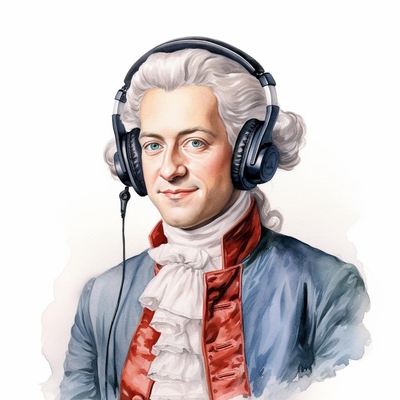MOZART'S EINE KLEINE NACHTMUSIK
- 'I. ALLEGRO' -

Hey there, I'm Wolfgang Amadeus Mozart, and I'm about to break down the Allegro movement from my banger 'Eine kleine Nachtmusik,' for ya. Are you keen to get the lowdown on why this piece slaps so hard? Chill, I'm here to guide you through the ins and outs of this kickin' Allegro. And after I spill the tea on these juicy details, I'll hit you up with some tips on how to dive even deeper into 'Eine kleine Nachtmusik.'
---
Instruments and Their Roles in 'I. Allegro'
Alright, imagine you're at the fanciest dinner party, and the host just brought out the main course - that's the vibe of 'I. Allegro'. You've got the strings - violins, violas, cellos, and double bass - they're like the life of the party, chatting away and setting the mood. The violins are the chatty ones, leading most of the conversation, while the violas, cellos, and bass provide the juicy gossip underneath. Listen for the way they play off each other, sometimes in unison, sometimes in a playful call and response - it's like a musical game of tag.Why 'I. Allegro' Got Its Groovy Name
So, why did I call this piece 'I. Allegro'? Well, 'allegro' means 'fast, lively, and brisk' - like a rabbit on an espresso shot. I wanted to capture that feeling of a spontaneous, impromptu gathering of friends, all buzzing with excitement. It's the kind of tune that gets your foot tapping without you even realizing it. And let's be honest, 'A Little Night Music' sounds way cooler in Italian - 'Eine kleine Nachtmusik' just rolls off the tongue, doesn't it?The Form of 'I. Allegro'
Choosing the form for 'I. Allegro' was an adventure in itself. I'll explain how the form is organized - it's a sonata, which is like the grand architecture of musical storytelling. I'll just touch on the sections here, but get ready, because I'm going to dive into each section one by one in the next few paragraphs. It's going to be an exciting exploration!Section 1: The Grand Entrance
The first section is all about making a grand entrance - think of it as the overture to a night of endless possibilities. It's in sonata form, which means we've got an exposition, a development, and a recapitulation - fancy words for 'meet, clash, and makeup'. The tempo is brisk, the mood is upbeat, and the key is a solid G major - it's like the musical equivalent of a firm handshake. This is where themes are introduced, like guests at a party, each one with its own unique flair.Section 2: The Plot Thickens
Moving on to the second section, this is where the plot thickens and the drama unfolds. We're in the development part now, where the themes from the exposition go on a wild adventure, exploring new keys and getting into all sorts of shenanigans. It's like a conversation that starts off about the weather and suddenly you're discussing the meaning of life. The music gets intense, the harmonies are more complex, and it feels like we're on a thrilling chase scene.Section 3: Déjà Vu with a Twist
Now we hit the third section, the recapitulation, where you'll get a sense of déjà vu, but with a twist. The themes from the exposition come back, but they've grown up a bit - they've seen things, they've changed. It's like coming home after a long journey, everything's familiar but you notice things you didn't before. The key is back to G major, and the mood is triumphant, like we've all made it through the adventure together.Invitation to Experience 'I. Allegro'
Now, I invite you to experience 'I. Allegro' for yourself. Hit the play button and let yourself be immersed in the music. As you listen, maybe keep in mind what we've talked about. I hope you find the journey through my 'I. Allegro' as thrilling as I did when creating it!---
Did ya have a blast diving into the groovy tunes of Eine kleine Nachtmusik's Allegro, or what? You know, there's a whole lot more to the jam session that is Eine kleine Nachtmusik than just the kick-off movement. Hit up these snazzy links to keep the good times rolling and explore every nook and cranny of this classical banger.
